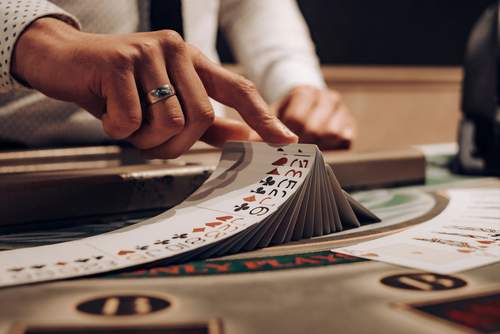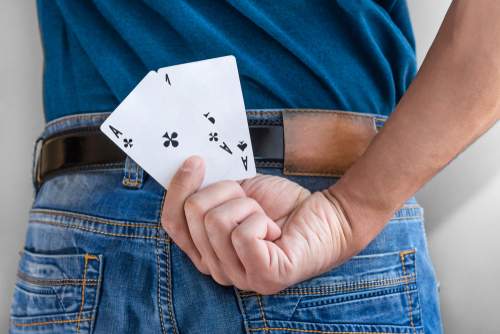Introduction:
Poker, a game that combines strategy, skill, and psychological warfare, has captivated players for generations. Whether played in smoky backrooms or online poker rooms, the thrill of outsmarting opponents and winning with a well-timed bluff is unmatched. In this article, we dive into the world of poker and explore essential strategies that can elevate your game and give you an edge at the table. From understanding hand rankings to mastering the art of reading opponents, get ready to unleash your poker skills and increase your chances of walking away a winner.
A key concept to understand in poker is pot odds. Pot odds refer to the ratio of the money in the pot compared to how much money you must invest to stay in the hand. This gives you a mathematical perspective on the risk and reward of whether or not it’s financially beneficial to stay in the hand. Ultimately, winning at poker requires carefully balancing the risks and rewards involved in each hand.
The ability to read opponents is also a crucial skill for poker success. As you get a feel for the game and the players in it, you can use the information you gather to help you make better decisions. Common tells like changes in hand position, betting patterns, and body language can be telling indicators about the strength of an opponent’s hand. Paying attention to these details can give you a sharp insight into how your opponents are likely to play the hand and help you make sound decisions.
By understanding the fundamentals of poker and developing a strong strategic foundation, you can become a more successful poker player with increased confidence in your skills. With practice and dedication, you can become the player who leaves the table a winner.
I. Understanding the Basics of Poker Skills

To become a formidable player, it’s crucial to have a solid understanding of the game’s fundamentals.
A. Hand Rankings:
Familiarize yourself with the hierarchy of poker hands, from the high card to the royal flush. Knowing the value of different hand combinations will guide your decision-making during gameplay.
In poker, the ranking of hands determines the strength of a player’s hand and the winner in a showdown. Here is a list of the standard poker hands, starting from the highest-ranking hand to the lowest:
Royal Flush:
The highest-ranking hand in poker is the royal flush. It consists of the Ace, King, Queen, Jack, and Ten in the same suit. For example, A♠K♠Q♠J♠10♠.
Straight Flush:
A straight flush is a sequence of five cards in numerical order, all of the same suit. For example, 8♥9♥10♥J♥Q♥. The highest-ranking straight flush is the royal flush.
Four of a Kind:
Four of a kind, also known as quads, is a hand with four cards of the same rank and one unrelated card. For example, 7♦7♠7♥7♣5♠.
Full House:
A full house consists of three cards of the same rank and two cards of another rank. For example, 9♣9♠9♦5♣5♠.
Flush:
A flush consists of any five cards of the same suit, not in numerical order. For example, 2♦5♦7♦9♦K♦.
Straight:
A straight is a hand with five cards in numerical order, but not all of the same suit. For example, 4♠5♣6♦7♥8♠.
Three of a Kind:
Three-of-a-kind, also known as trips or a set, is a hand with three cards of the same rank and two unrelated cards. For example, Q♠Q♥Q♦9♣2♠.
Two Pair:
Two pair consists of two cards of the same rank, another two cards of a different rank, and one unrelated card. For example, 10♣10♠5♦5♣J♠.
One Pair:
One pair is a hand with two cards of the same rank and three unrelated cards. For example, 6♠6♥K♦8♣3♠.
High Card:
If no player has any of the above hands, the player with the highest-ranking card wins. The high card hand is simply the highest-ranking card held by a player. For example, if no player has a pair or better, the player with the highest single card wins.
It’s worth noting that in some poker variations, such as Omaha or Seven-Card Stud, the hand rankings may remain the same, but players use a combination of their hole cards and community cards to make the best possible hand.
B. Different Poker Variations:
Explore popular poker variations, such as Texas Hold’em, Omaha, and Seven-Card Stud. Each variation has its own rules and strategies, so choose the one that suits your preferences and style of play.
C. Betting Structures:
Understand the different betting structures in poker, including fixed limit, pot limit, and no limit. Each structure influences the dynamics of the game and requires a unique approach to betting.
II. Mastering Pre-Flop Strategy

The decisions you make before the flop can set the tone for the entire hand. Developing a solid pre-flop strategy is essential for long-term success.
Knowing the right decisions to make before the flop can help you stay ahead of your opponents. When you are dealt a hand, you have the opportunity to figure out what range of cards you are likely holding and what range your opponents might be holding. This knowledge can help you gain an edge over your opponents. Paying close attention to the board and the opponents’ actions can help give you even more of an understanding. Knowing the tendencies of your opponents is also crucial. Paying attention to the types of hands they tend to raise or call pre-flop can give you a better understanding of their actions during the hand. Additionally, having a good understanding of the subtleties of pre-flop play can be beneficial in a variety of different situations.
A. Starting Hand Selection:
Learn which starting hands have the highest probability of winning and which ones should be folded. Understand the concept of hand strength and play accordingly.
Observe experienced players to learn their strategies and note how they make decisions. Decide, based on your knowledge and skills, when to be aggressive and when to passively accept a smaller profit. When you have confidence in your decision-making, you will be able to extract more value from your hands. Develop an understanding of when you have a hand that you feel is good and when you are better off with a cautious approach. With enough practice, you will be able to employ a winning strategy in poker.
B. Positional Awareness:
Recognize the importance of position at the poker table. Understand how your position relative to the dealer affects your decision-making and leverage it to gain an advantage over opponents.
Additionally, think about the way that your seat position influences your opponents as well. Experienced players will factor in which players are to their left and right, as this will give them vital information about their opponents’ strategies. Learning to utilize the strategic advantages of a position to gain an edge over your opponents is a critical skill in poker.
C. Reading Opponents:
Pay close attention to your opponent’s actions and betting patterns. Look for patterns that reveal their playing style, tendencies, and possible weaknesses.
Note which hands they are consistently raising, calling, or folding. Look at how much they bet pre-flop and post-flop and how they relate to what type of hands they might have. Also, observe their willingness to enter or exit a pot. This can reveal a lot about the strength of their hands.
Always bear in mind that playing decisions are made much more quickly online than in live games. Also, be aware that other players may be tracking your playing patterns, so be mindful of giving away too much information. Try to keep track of your opponents and pay attention to any unusual playing behavior. In addition, take advantage of the hand history features to review your play and your opponents’ play.
Make sure to also pay attention to your opponent’s stack sizes, as this could give you a better idea of their overall strategy. This can also help you determine when it is the best time to bet or fold. Finally, be sure to set appropriate time limits and quit playing when you reach these limits. Playing for too long can lead to mistakes being made and it can also lead to potential burnout.
III. Navigating the Flop, Turn, and River
Once the community cards are revealed, the game intensifies. Knowing how to analyze the board and make calculated decisions is crucial.
A. Evaluating Hand Potential:
Assess the strength of your hand about the community cards. Determine the likelihood of completing your hand and adjust your betting strategy accordingly.
Think about the amount of money you are willing to invest in the pot and what cards you need to make your hand. If you have a high likelihood of completing your hand, you can bet more aggressively. However, if it looks like there are cards on the board that can hurt your hand, you may want to be more conservative in your betting strategy. Knowing when to bet more and when to fold is key to winning with a particular hand.
B. Pot Odds and Implied Odds:
Understand the concept of pot odds and implied odds to make informed decisions about whether to call, raise, or fold. Calculating the potential return on investment can guide your actions.
Knowing the size of the pot and understanding the potential winnings involved with calling with a particular hand is the key to an efficient poker strategy. Pot odds determine how much money is already in the pot versus how much money it would cost to call. Implied odds factor in potential winnings or losses on future rounds of betting. Calculating these two figures can help you make decisions about whether to call or fold with greater accuracy.
C. Bluffing and Semi-Bluffing:
Master the art of bluffing by strategically representing a stronger hand than you hold. Semi-bluffing, where you have a drawing hand with potential, can add another layer of deception to your game.
An effective bluff should also take into account the psychological aspects of the game. Try striking a balance between bluffing and not bluffing; both aggressive and tight bluffing have their risks and rewards. Be aware of the players you’re bluffing, their tendencies, and how they tend to react under pressure. Know when and how to adjust your bluffing strategy as the game progresses. By mastering the art of bluffing, you can gain an edge over your opponents and maximize your winnings.
IV. Developing a Solid Post-Flop Strategy

The post-flop stage requires adaptability and the ability to make well-timed moves based on changing circumstances.
A. Continuation Betting:
Utilize the continuation bet to maintain control of the pot and put pressure on opponents. A well-executed continuation bet can force opponents to fold weak hands.
Continuation bets force opponents to act on their hands and make challenging decisions that can cost them valuable chips. It is important to recognize situations where a continuation bet will not be effective, such as when facing a pre-flop raiser or when there are multiple opponents in the pot. In these situations, opting to check instead of betting might be the more profitable option.
B. Extracting Value:
When you have a strong hand, focus on extracting maximum value from your opponents. Make calculated bets and raises to entice them into putting more chips into the pot.
You should also be aware of their tendencies and playing style to determine when to bluff or when you are holding a really strong hand. If your opponent plays too tight, then a well-timed bluff might be effective. If their playing style is more aggressive, then you know that their hands will likely be weak, and you should value bet more often. When your opponent has shown a certain amount of strength, consider betting for value and protection rather than just betting as a bluff. Overall, your mindset should be to ensure you get maximum value out of any strong hands that you hold.
C. Pot Control:
Exercise caution when facing aggressive opponents or dangerous board textures. Employ pot control techniques to minimize losses and protect your stack.
To further protect your stack, it is important to make conservative card plays. If you have a hand that may be vulnerable, you should consider leading out with the lowest card or folding to an aggressive lead. Additionally, always review hand histories after each game to spot any leaks and adjust your strategy accordingly. Learning when to fold or call in difficult spots can mean the difference between winning or losing the hand.
V. The Importance of Table Image and Psychology
Poker is not solely about the cards you hold; it’s also about the image you project and your ability to exploit the psychology of your opponents.
A. Table Image:
Be aware of your table image and how other players perceive you. Adjust your strategy accordingly to take advantage of their perceptions.
One common misperception players have is that they are playing against a single opponent when in reality you are playing against all the players at the table. You should conduct yourself with confidence to give a good impression to the other players but remember they are all there to compete with you. Make sure to be aware of the big picture and the strategy of all the other players and do not get too focused on one player. That way you can formulate a better strategy for yourself and take advantage of the misperceptions the other players have.
B. Reading Tells:
Develop the skill of reading physical and verbal cues, commonly referred to as “tells,” that reveal information about opponents’ hands. Pay attention to their body language, betting patterns, and reactions to gain valuable insights.
Analyze your opponents and their tendencies. Track their betting patterns and study their behavior to ascertain their tendency to bluff or play aggressively. This can help you judge when you can safely call or fold. Be aware of the strategic implications of your position in the game. Familiarize yourself with position play and strategic concepts like the strength in late position, the importance of pot odds, and the basic betting strategies, so that you can make the best possible play. And lastly, practice! As you play more hands, it will be easier for you to read different tells and to improve your game.
C. Emotional Control:
Maintain emotional control and avoid giving away your tells. Emotional stability is key to making rational decisions and executing strategic plays.
It is important to take breaks and clear your mind between hands. Focusing only on the game can create a mindset that does not allow for healthy emotional and mental balance. Regardless of how well or poorly a hand turns out, it is important to maintain an even emotional keel and not let your emotions get the best of you. Keep track of the game, and how each decision you make impacts your chance of success. Taking the time to study your own hands and accurately assess the situation is key to making the right decisions to win.
Conclusion:
Poker is a game that combines strategy, skill, and psychological prowess. By understanding the basics of poker, mastering pre-flop and post-flop strategies, and leveraging table images and psychology, you can enhance your chances of success at the poker table. Remember that practice, experience, and continual learning are essential for improving your skills. So, unleash your poker skills, embrace the challenges, and enjoy the thrilling ride that this timeless game has to offer. Good luck and may the cards be in your favour!
Whether you are a beginner or a professional poker player, you should focus on sharpening your skills and knowledge to increase your odds of winning. There are numerous books, online articles, and videos available that can help you learn and improve your overall game. To stay ahead of other players, it is important to frequently challenge yourself, practice, and stay up-to-date with the latest strategies. All these elements can help increase your chances of garnering success at the poker table.
Furthermore, to build a successful poker career, it is important not to only become a master of the game, but also to understand the behaviors and emotions of other players. While understanding their motivations can be quite difficult, practicing and paying attention to your opponents’ strategies can help you gain insights into their reasoning. Being aware of other players’ play-styles can help you plan your own more effectively, and significantly improve your chances of winning.